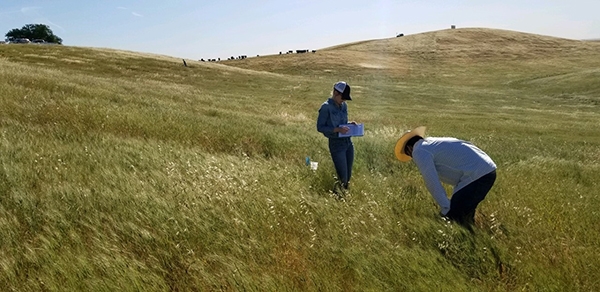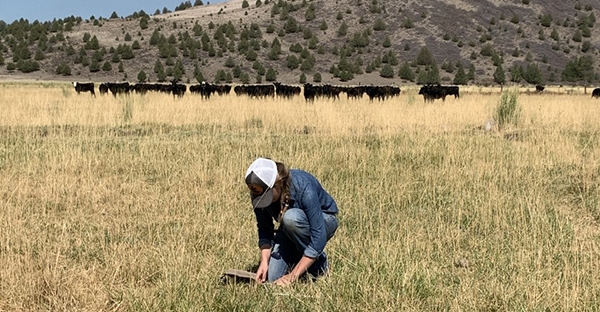
“California's historic drought presents an opportunity to apply insight from on-the-ground managers to develop future adaptation and mitigation strategies for management and policy decision-making. Ranchers are among the first to experience the social, economic, and environmental impacts of drought, so they are essential in co-developing management and policy guidance for building rangeland resilience to drought,” says Grace Woodmansee, UC ANR Livestock and Natural Resources Advisor in Siskiyou County.
Woodmansee is relatively new to her position, having started in January of 2021, but she is not new to UC ANR. She grew up in Chico, California, raised market lambs through 4-H, and eventually earned an undergraduate degree from Chico State. As an undergraduate, she interned with UC Cooperative Extension and was drawn to how connected county advisors were to their communities.
She continued to pursue this work through graduate school. “My interest in rangeland management and Cooperative Extension expanded while serving as a research assistant in the UC Rangelands lab at UC Davis, where I completed my Master of Science in Agronomy in November 2020,” Woodmansee explains.
While conducting graduate research, Woodmansee worked with UC ANR's Dan Macon, Tracy Schohr, and Leslie Roche to analyze data from interviews of rangeland livestock producers collected near the end of California's last historic drought in 2016. The team asked 48 rangeland livestock producers about what proactive strategies they used to prepare for drought and what reactive actions they took to respond to drought. The managers then ranked the effectiveness each practice.
Through the interviews, Woodmansee and her colleagues explored whether multi-species grazing was effective as a proactive drought management strategy. Multi-species grazing means that a mix of livestock, such as sheep and cattle, who like to eat different plants, graze the land. This may allow ranchers to stretch the available forage during a drought year. The interviews revealed that multi-species ranchers managed drought in a greater variety of ways. Indeed, multi-species grazing seems to allow for greater flexibility in coping with drought.
“Surprisingly, some of the least-used management strategies were ranked as most effective by ranchers. For example, we found that multi-species grazing was the least-used proactive drought management practice, but was the highest ranked proactive practice based on perceived effectiveness by ranchers,” Woodmansee observed. As extreme, multi-year droughts become more common, strategies that were ranked as highly effective by ranchers may be the best hope for mitigating future drought impacts.
These results led Woodmansee and her colleagues to conclude that prioritizing management flexibility is the most effective way for ranchers and land managers to manage drought. “A diversity of both proactive and reactive drought management strategies will continue to be a critical component of building ranch resilience, particularly during multi-year droughts,” says Woodmansee.
As for the future, Woodmansee is excited to be a part of the Siskiyou County community and to work with ranchers and land managers to identify research priorities and projects that will not only address livestock production but also contribute to solutions for natural resource management challenges. She hopes to continue working on drought-related research, contribute to increasing wildfire preparedness, and support disaster planning for commercial livestock operators.
“It can be overwhelming to think about the effects of complex natural disasters occurring simultaneously, such as drought and wildfire, and how to support land managers as they manage through these challenges,” Woodmansee reflects, noting that Siskiyou County has been under extreme drought conditions for over a year and the impacts on forage production, irrigation water availability, and fire danger this spring are apparent to her. “But I am excited to be working with motivated and innovative folks, including ranchers, extension colleagues, agency personnel, and community members, to solve water-related challenges.”

